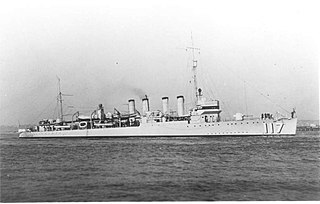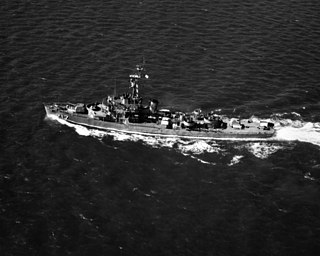
USS Saginaw Bay (CVE-82) was a Casablanca-class escort carrier of the United States Navy. It was named after Saginaw Bay, located within Kuiu Island. The bay was in turn named after USS Saginaw, a U.S. Navy sloop-of-war that spent 1868 and 1869 charting and exploring the Alaskan coast. Launched in January 1944, and commissioned in March, she served in support of the Mariana and Palau Islands campaign, the Philippines campaign, the Invasion of Iwo Jima, and the Battle of Okinawa. Postwar, she participated in Operation Magic Carpet. She was decommissioned in April 1946, when she was mothballed in the Atlantic Reserve Fleet. Ultimately, she was sold for scrapping in November 1959.

USS McCord (DD-534) was a World War II-era Fletcher-class destroyer in the service of the United States Navy.

USS Dennis (DE-405) was a John C. Butler-class destroyer escort in the service with the United States Navy from 1944 to 1946. She was scrapped in 1973.

USS John C. Butler (DE-339) was the lead ship of her class of destroyer escorts in the service with the United States Navy from 1944 to 1946. She was recommissioned between 1950 and 1957 and finally sunk as a target in 1971.

USS Helm (DD-388) was a Bagley-class destroyer in the United States Navy during World War II. She was named for Rear Admiral James Meredith Helm. Helm received 11 battle stars for her World War II service in the Pacific.

USS Dorsey (DD–117), reclassified DMS-1 on 19 November 1940, was a Wickes-class destroyer in the United States Navy during World War I. She was named for John Dorsey.

USS Owen (DD-536), was a Fletcher-class destroyer of the United States Navy.

USS Wedderburn (DD-684), was a Fletcher-class destroyer of the United States Navy.

USS O'Flaherty (DE-340) was a John C. Butler-class destroyer escort built for the United States Navy during World War II. She was named for Ensign Frank Woodrow O'Flaherty, a pilot who posthumously received the Navy Cross for his actions at the Battle of Midway.

USS Halligan (DD-584) was a Fletcher-class destroyer of the United States Navy, named for Rear Admiral John Halligan, Jr. (1876–1934).

USS Capps (DD-550), a Fletcher-class destroyer, was a ship of the United States Navy named for Rear Admiral Washington L. Capps (1864–1935).

USS Haggard (DD-555) was a Fletcher-class destroyer of the United States Navy named for Captain Haggard of the Louisa, who fought in the Quasi-War.

USS Porterfield (DD-682) was a Fletcher-class destroyer of the United States Navy. She was laid down by the Bethlehem Shipbuilding, San Pedro, California 12 December 1942; launched 13 June 1943; sponsored by Mrs Louis B. Porterfield and commissioned 30 October 1943, with Commander J. C. Woefel in command.

USS Coolbaugh (DE-217) was a Buckley-class destroyer escort in service with the United States Navy from 1943 to 1960. She was scrapped in 1973.

USS Stadtfeld (DE-29) was an Evarts-class destroyer escort constructed for the United States Navy during World War II. It was promptly sent off into the Pacific Ocean to protect convoys and other ships from Japanese submarines and fighter aircraft. By the end of the war, when she returned to the United States, she was awarded four battle stars.

USS Riddle (DE-185) was a Cannon-class destroyer escort in service with the United States Navy from 1943 to 1946. In 1950, she was transferred to France where she served as Kabyle (F718) until being decommissioned and scrapped in 1959.

USS Richard S. Bull (DE-402) was a John C. Butler-class destroyer escort in service with the United States Navy from 1944 to 1946. She was finally sunk as a target in 1969.

USS Richard M. Rowell (DE-403) was a John C. Butler-class destroyer escort acquired by the United States Navy during World War II. The primary purpose of the destroyer escort was to escort and protect ships in convoy, in addition to other tasks as assigned, such as patrol or radar picket. During her career she earned six battle stars to her credit.

USS Edmonds (DE-406) was a John C. Butler-class destroyer escort in service with the United States Navy from 1944 to 1946 and from 1951 to 1965. She was scrapped in 1973.

USS Howard F. Clark (DE-533) was a John C. Butler-class destroyer escort in service with the United States Navy from 1944 to 1946. She was sold for scrapping in 1973.




















